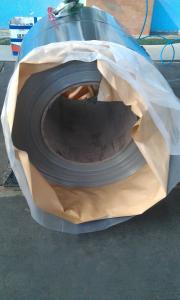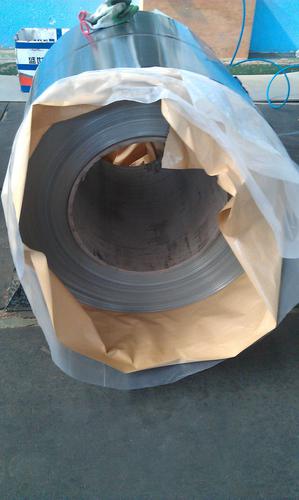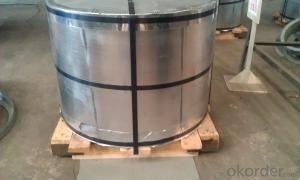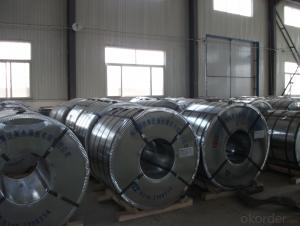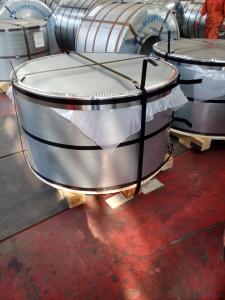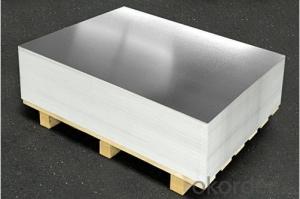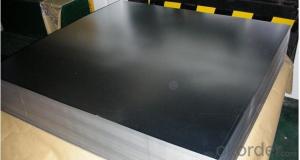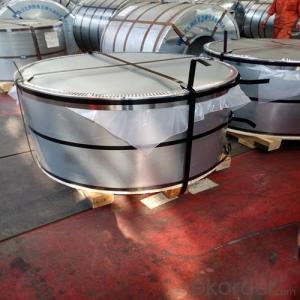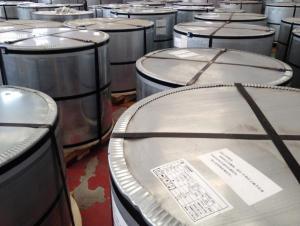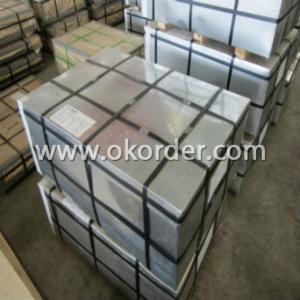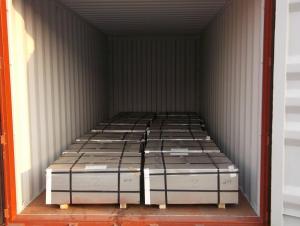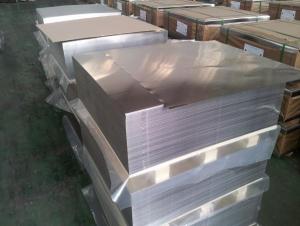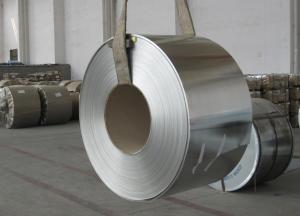Electrolytic Tinplate for Metal Package of Industrial or Chemical Use
- Loading Port:
- Shanghai
- Payment Terms:
- TT OR LC
- Min Order Qty:
- 25 m.t.
- Supply Capability:
- 30000 m.t./month
OKorder Service Pledge
OKorder Financial Service
You Might Also Like
Specification
1.Structure of Electrolytic Tinplate for Metal Package of Industrial or Chemical Use Description
Tinplate, thin steel sheet with a coating of tin applied either by dipping in molten metal or by electrolytic deposition; almost all tinplate is now produced by the latter process. Tinplate made by this process is essentially a sandwich in which the central core is strip steel. This core is cleaned in a pickling solution and then fed through tanks containing electrolyte, where tin is deposited on both sides. As the strip passes between high-frequency electric induction coils, it is heated so that the tin coating melts and flows to form a lustrous coat.
2.Main Features of the Electrolytic Tinplate for Metal Package of Industrial or Chemical Use
Appearance – Tinplate is characterized by its beautiful metallic luster. Products with various kinds of surface roughness are produced by selecting the surface finish of the substrate steel sheet.
Paintability and printability – Tinplates have excellent paintability and printability. Printing is beautifully finished using various lacquers and inks.
Formability and strength – Tinplates have got very good formability and strength. By selecting a proper temper grade, appropriate formability is obtained for different applications as well as the required strength after forming.
Corrosion resistance – Tinplate has got good corrosion resistance. By selecting a proper coating weight, appropriate corrosion resistance is obtained against container contents. Coated items should meet 24 hour 5 % salt spray requirement.
Solderability and weldability – Tinplates can be joined both by soldering or welding. These properties of tinplate are used for making various types of cans.
Hygienic – Tin coating provides good and non toxic barrier properties to protect food products from impurities, bacteria, moisture, light and odours.
Safe – Tinplate being low weight and high strength makes food cans easy to ship and transport.
Eco friendly – Tinplate offers 100 % recyclability.
Tin is not good for low temperature applications since it changes structure and loses adhesion when exposed to temperatures below – 40 deg C.
3.Electrolytic Tinplate for Metal Package of Industrial or Chemical Use Images
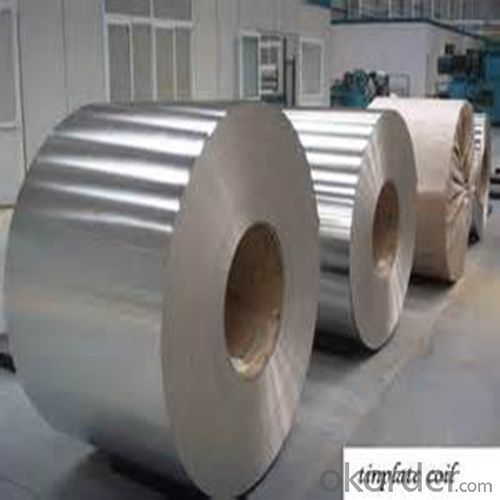
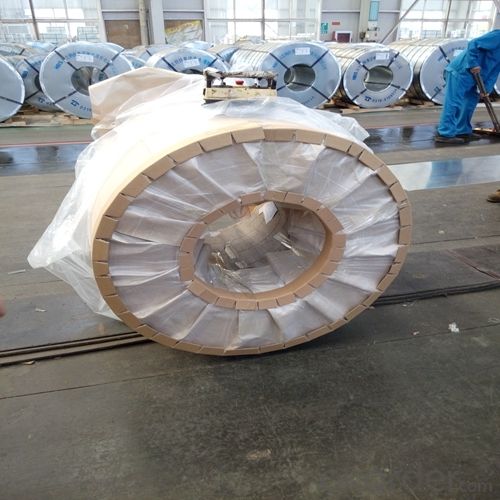
4.Electrolytic Tinplate for Metal Package of Industrial or Chemical Use Specification
Specification of :
Standard: ISO 11949 -1995, GB/T2520-2000,JIS G3303,ASTM A623, BS EN 10202
Material: MR,SPCC
Thickness:0.15mm - 0.50mm
Width: 600mm -1150mm
Temper: T1-T5
Annealing: BA & CA
Coil Inner Diameter: 508mm
Weight: 6-10 tons/coil 1~1.7 tons/sheets bundle
Passivation:311
Oil: DOS
Surface: Finish,bright,stone,matte,silver
5.FAQ of Electrolytic Tinplate for Metal Package of Industrial or Chemical Use
- What is tinning and how does it work?
Tinning is the process of thinly coating sheets of wrought iron or steel with tin, and the resulting product is known as tinplate. It is most often used to prevent rust.
- Do you only have prime quality tinplate?
We can supply both prime and second quality tinplate.
- Q: Can tinplate be welded or soldered?
- Yes, tinplate can be welded or soldered.
- Q: Can tinplate be used for aerospace applications?
- Yes, tinplate can be used for certain aerospace applications, particularly for non-critical components where weight is not a significant concern. Tinplate is known for its corrosion resistance and affordability, which makes it suitable for certain aerospace applications such as interior fittings, non-structural parts, and packaging. However, for critical components that require high strength-to-weight ratio or extreme durability, other materials like aluminum or titanium are typically preferred.
- Q: How does tinplate contribute to the durability of stationery products?
- Tinplate contributes to the durability of stationery products by providing a protective and corrosion-resistant coating. This helps prevent the stationery products from rusting, bending, or getting damaged due to moisture or other environmental factors. Additionally, tinplate adds strength and rigidity to the products, making them more resistant to wear and tear, thus enhancing their overall durability.
- Q: What are the advantages of using tinplate for packaging?
- Tinplate offers several advantages for packaging. Firstly, it provides excellent protection against moisture, air, and light, which helps in preserving the quality and freshness of the packaged product. Secondly, tinplate is highly durable and can withstand rough handling during transportation and storage. It also offers resistance against corrosion, ensuring the longevity of the packaging. Additionally, tinplate is easily recyclable, making it an environmentally friendly choice. Lastly, tinplate can be shaped into various sizes and designs, allowing for attractive and customized packaging options.
- Q: How to quickly open the bottle?
- A tin can be opened, the handle is separated, and the canned fruit can be clamped by the head, and the rotating knob and the tin can be opened. Remember, when you turn the knob, you can only rotate clockwise and turn counterclockwise clockwise.
- Q: How to prevent the corrosion of tinplate wall hydrogen sulfide blackening, expansion
- Coating anticorrosionThe regular in metal storage tank inner wall spraying anti-corrosion coating, such as epoxy resin or lacquer layers.Spraying antirust paint on the pipeline and oil pump which are exposed to the atmosphere in a certain period.Setting up oil pipelines on the surface of the ground, to remove stagnant water and prevent soaking, so as not to peel off the coating.The movable metal parts in the oil tank equipment, such as the valves of the pipeline, should be coated with antirust grease or grease to prevent moisture from entering through the valve screw and causing corrosion. Outdoor doors should be equipped with protective covers to prevent rainwater from washing off the rust proof layer.The terminal is often set in the pipeline and equipment should be sprayed on the wet, corrosion or rust proof grease grease for protection of good standing.
- Q: What are the main factors influencing the pricing of tinplate?
- The main factors influencing the pricing of tinplate include the cost of raw materials, such as tin and steel, market demand and supply dynamics, production and manufacturing costs, currency exchange rates, and government regulations. Additionally, factors like changes in global trade policies, geopolitical tensions, and overall economic conditions can also impact the pricing of tinplate.
- Q: Can tinplate be formed into complex shapes?
- Yes, tinplate can be easily formed into complex shapes due to its malleability and ability to be shaped and molded without breaking or losing its structural integrity.
- Q: What are the main applications of tinplate in the pet food industry?
- Tinplate is commonly used in the pet food industry for packaging purposes. It offers excellent protection against oxygen, light, and moisture, which helps to maintain the freshness and quality of pet food. Additionally, tinplate cans are easy to open and reseal, making them convenient for pet owners. The material is also recyclable, making it an environmentally friendly choice for packaging.
- Q: Can tinplate be used for coffee or tea packaging?
- Yes, tinplate can be used for coffee or tea packaging. Tinplate is a durable and food-safe material that provides excellent protection against moisture, light, and oxygen, making it an ideal choice for preserving the quality and freshness of coffee or tea. Additionally, tinplate can be easily shaped and printed on, allowing for attractive and customized packaging designs.
Send your message to us
Electrolytic Tinplate for Metal Package of Industrial or Chemical Use
- Loading Port:
- Shanghai
- Payment Terms:
- TT OR LC
- Min Order Qty:
- 25 m.t.
- Supply Capability:
- 30000 m.t./month
OKorder Service Pledge
OKorder Financial Service
Similar products
Hot products
Hot Searches
Related keywords
